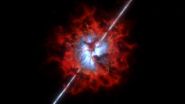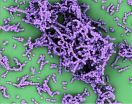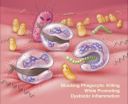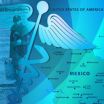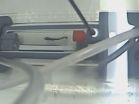Gigantic explosion buried in dust: ALMA probes environment around gamma ray bursts
2014-06-11
Using the Atacama Large Millimeter/submillimeter Array (ALMA), a team of researchers reports the first-ever detection of molecular gas -- the fuel for star formation -- in two galaxies that were previously rocked by gamma ray bursts (GRBs), the brightest explosions in the Universe. These new observations revealed that the molecular gas was concentrated toward the centers of the galaxies, while the GRBs occurred in unusual environments that were surprisingly bereft of gas yet rich in dust.
The researchers speculate that the dearth of molecular gas around the GRBs was due ...
Breakthrough study sheds new light on best medication for children with seizures
2014-06-11
DETROIT – A recently published clinical study in the Journal of the American Medical Association has answered an urgent question that long puzzled ER pediatricians: Is the drug lorazepam really safer and more effective than diazepam – the U.S. Food and Drug Administration-approved medication as first line therapy most often used by emergency room doctors to control major epileptic seizures in children?
The answer to that question – based on a double-blind, randomized clinical trial that compared outcomes in 273 seizure patients, about half of whom were given lorazepam ...
Why aren't product designers considering activity trackers for older adults?
2014-06-11
Commercially available activity-monitoring apps, Web sites, and wearable devices allow for easy self-management of health and wellness. This technology may be particularly helpful for older adults, who can improve their cognitive function through proper diet and exercise. Despite tracking monitors' growing popularity and potential benefits, product designers rarely consider those over 65 to be a viable user group, and new human factors/ergonomics research indicates that the technology presents several usability challenges for this population.
"Many older adults have ...
A key step toward a safer strep vaccine
2014-06-11
An international team of scientists, led by researchers at the University of California, San Diego School of Medicine, have identified the genes encoding a molecule that famously defines Group A Streptococcus (strep), a pathogenic bacterial species responsible for more than 700 million infections worldwide each year.
The findings, published online in the June 11 issue of Cell Host & Microbe, shed new light on how strep bacteria resists the human immune system and provides a new strategy for developing a safe and broadly effective vaccine against strep throat, necrotizing ...
A NASA view of Tropical Cyclone Nanauk in the Arabian Sea
2014-06-11
Tropical Cyclone 02A has consolidated and strengthened over a 24 hour period between June 10 and 11 and an image from NASA's Aqua satellite showed a more rounded tropical storm, despite wind shear.
As Tropical Cyclone 02A consolidated and strengthened into a tropical storm it was re-named Nanauk. NASA's Aqua satellite passed over Nanauk on June 11 at 08:29 UTC (4:29 a.m. EDT) and the Atmospheric Infrared Sounder (AIRS) captured an infrared and near-infrared image of the storm. The near-infrared image provided an almost visible look at the clouds that revealed a well-rounded ...
Gum disease bacteria selectively disarm immune system, Penn study finds
2014-06-11
The human body is comprised of roughly 10 times more bacterial cells than human cells. In healthy people, these bacteria are typically harmless and often helpful, keeping disease-causing microbes at bay. But, when disturbances knock these bacterial populations out of balance, illnesses can arise. Periodontitis, a severe form of gum disease, is one example.
In a new study, University of Pennsylvania researchers show that bacteria responsible for many cases of periodontitis cause this imbalance, known as dysbiosis, with a sophisticated, two-prong manipulation of the human ...
Migrating north may trigger immediate health declines among Mexicans
2014-06-11
PRINCETON, N.J.—Mexican immigrants who relocate to the United States often face barriers like poorly paying jobs, crowded housing and family separation. Such obstacles – including the migration process itself – may be detrimental to the health of Mexican immigrants, especially those who have recently moved.
A study led by Princeton University's Woodrow Wilson School of Public and International Affairs finds that Mexican immigrants who relocate to the United States are more likely to experience declines in health within a short time period compared with other Mexicans. ...
New study finds Internet not responsible for dying newspapers
2014-06-11
We all know that the Internet has killed the traditional newspaper trade, right? After all, until the general population started interacting with the web in the mid-90s, the newspaper business was thriving—offering readers top notch journalism and pages of ads.
But a recently-published study finds that we may be all wrong about the role of the Internet in the decline of newspapers.
According to research by University of Chicago Booth School of Business Professor Matthew Gentzkow, assumptions about journalism are based on three false premises.
In his new paper, "Trading ...
Study shows Deepwater Horizon crude oil impairs swimming performance of juvenile mahi-mahi
2014-06-11
VIDEO:
This shows juvenile Mahi-mahi in swim tunnel, which allows scientists to monitor metabolic rate swim performance.
Click here for more information.
MIAMI – A new study led by University of Miami (UM) Rosenstiel School of Marine and Atmospheric Science scientists showed up to a 37% decrease in overall swimming performance of Deepwater Horizon oil-exposed juvenile mahi-mahi. The findings reveal the toxic effects of crude oil on ecologically and commercially valuable fish ...
Survey: Almost all adult Texans knew about Health Insurance Marketplace during open enrollment
2014-06-11
HOUSTON – (June 11, 2014) – Almost all adult Texans were aware of the Affordable Care Act's Health Insurance Marketplace before the open-enrollment period ended March 31, according to a report released today by Rice University's Baker Institute for Public Policy and the Episcopal Health Foundation.
The report also found that an estimated 2 million Texans looked for information about the Marketplace and found the federal healthcare.gov website generally helpful. Almost half of Texans who visited the site wanted to purchase insurance or check their eligibility for a ...
White bread helps boost some of the gut's 'good' microbes
2014-06-11
White-bread lovers take heart. Scientists are now reporting that this much-maligned food seems to encourage the growth of some of our most helpful inhabitants — beneficial gut bacteria. In addition to this surprising find, their study in ACS' Journal of Agricultural and Food Chemistry also revealed that when looking at effects of food on our "microbiomes," considering the whole diet, not just individual ingredients, is critical.
Sonia González and colleagues note that the bacteria in our guts, or our microbiome, play an important role in our health. When certain populations ...
Researchers uncover common heart drug's link to diabetes
2014-06-11
Hamilton, ON (June 11, 2014) - McMaster University researchers may have found a novel way to suppress the devastating side effect of statins, one of the worlds' most widely used drugs to lower cholesterol and prevent heart disease.
The research team—led by Jonathan Schertzer, assistant professor of Biochemistry and Biomedical Sciences and Canadian Diabetes Association Scholar—discovered one of the pathways that link statins to diabetes. Their findings could lead to the next generation of statins by informing potential combination therapies while taking the drug.
Approximately ...
Study identifies risk factors for hospital readmissions
2014-06-11
WINSTON-SALEM, N.C. – June 11, 2014 – Hospital readmission, an important measure of quality care, costs the United States an estimated $17 billion each year. And according to the Centers for Medicare and Medicaid Services (CMS), about half of those readmissions could be avoided.
Therefore, there is significant interest in identifying factors that influence readmission rates, especially those that can be identified prior to discharge.
To pinpoint which stroke patients are most at risk, researchers at Wake Forest Baptist Medical Center undertook a retrospective case-control ...
Peer pressure is weaker for kids to quit smoking
2014-06-11
Adolescents tend to be more powerful in influencing their friends to start smoking than in helping them to quit, according to sociologists.
In a study of adolescent friendship networks and smoking use over time, the researchers found that friends exert influence on their peers to both start and quit smoking, but the influence to start is stronger.
"What we found is that social influence matters, it leads nonsmoking friends into smoking and nonsmoking friends can turn smoking friends into nonsmokers," said Steven Haas, associate professor of sociology and demography, ...
Sun emits 3 X-class flares in 2 days
2014-06-11
On June 11, 2014, the sun erupted with its third X-class flare in two days. The flare was classified as an X1.0 and it peaked at 5:06 a.m. EDT. Images of the flare were captured by NASA's Solar Dynamics Observatory. All three flares originated from an active region on the sun that recently rotated into view over the left limb of the sun.
To see how this event may affect Earth, please visit NOAA's Space Weather Prediction Center at http://spaceweather.gov, the U.S. government's official source for space weather forecasts, alerts, watches and warnings.
To see a video ...
Harvard study finds substance abuse & mental health problems in MSM interfere with HIV medication adherence
2014-06-11
New Rochelle, NY, June 11, 2014—Men who have sex with men (MSM) account for more than 60% of HIV infections in the U.S. and 78% of new infections in men. Antiretroviral therapy can control HIV infection and suppress viral load, but mental health and substance abuse problems common among MSM can interfere with medication adherence. How conditions such as depression and alcohol and drug abuse can affect anti-HIV therapy and the success of various interventions are explored in an article published in LGBT Health, a peer-reviewed journal from Mary Ann Liebert, Inc., publishers. ...
What's the best way for toddlers to acquire verb meaning?
2014-06-11
EVANSTON, Ill. - New research is shedding light on what kind of sentences are best at facilitating the growth of toddlers' vocabularies.
A new study conducted at Northwestern University provides evidence that toddlers can learn verbs after hearing them only twice.
Sandra R. Waxman, Louis W. Menk Professor of Psychology at Northwestern University and Sudha Arunachalam, formerly a postdoctoral fellow at Northwestern, note that previous studies have shown that children as young as two years of age can successfully learn novel verbs after they've heard the verb many times ...
Company man or family man? Fatherhood and identity in the office
2014-06-11
There is no "one size fits all" image of how men view their role as fathers within the context of the workplace. However, fatherhood is becoming a more serious and time consuming role for men to fulfill. Therefore employers must acknowledge that many fathers want to be more than just traditional "organization men" who dedicate their life to their work. These insights come from Beth Humberd of the University of Massachusetts, Lowell, in the US, one of the authors of a study about how professional men experience fatherhood in the context of their workplace. The article appears ...
Health of Hispanic moms and babies a growing concern, new report says
2014-06-11
New York, New York —
Hispanic women are significantly more likely to have a baby with a neural tube birth defect, and nearly a quarter of all preterm births in the United States are Hispanic, according to a new report from the March of Dimes.
The report is available in English and Spanish and can be view at:
http://www.marchofdimes.com/Peristats/pdflib/991/MOD_2014HispanicReport.pdf
http://www.marchofdimes.com/Peristats/pdflib/991/MOD_2014HispanicReport_Spanish.pdf
Thalia, a global ambassador for the March of Dimes, and Latin Grammy Award-winning artist and mother ...
China today: Culprit, victim or last best hope for a global ecological civilisation?
2014-06-11
China, from 2015 the world's biggest economy, is its worst polluter already now. It has not yet, but will be most probably climbing the top position also with regards the aggregate contribution to climate change (historical emission residues included), called the climate debt. At the same time, it is the largest victim of environmental change, and the leading country in cleaning-up the environmental mess - the government has taken bold steps towards improvement. Could the largest polluter become the world's last best hope for establishing a global ecological civilisation? ...
Cristina now a hurricane, NASA's TRMM satellite sees heavy rainfall within
2014-06-11
Before Tropical Storm Cristina intensified into a hurricane, NASA's TRMM satellite passed overhead and gathered data that showed areas of heavy rainfall were occurring within.
The National Hurricane Center (NHC) upgraded the third tropical depression of the Eastern Pacific Ocean to tropical storm status and named it Cristina on June 10 at 0300 UTC (8 p.m. PDT). Earlier that morning at 1238 UTC (5:38 a.m. PDT), the Tropical Rainfall Measuring Mission (TRMM) satellite flew over the depression and gathered rainfall data that hinted that the storm was intensifying. At NASA's ...
The solar wind breaks through the Earth's magnetic field
2014-06-11
Space is not empty. A wind of charged particles blows outwards from the Sun, carrying a magnetic field with it. Sometimes this solar wind can break through the Earth's magnetic field. Researchers at the Swedish Institute of Space Physics (IRF) in Uppsala now have an answer to one of the questions about how this actually occurs.
When two areas with plasma (electrically charged gas) and magnetic fields with different orientations collide, the magnetic fields can be "clipped off" and "reconnected" so that the topology of the magnetic field is changed. This magnetic reconnection ...
It's the last bite that keeps you coming back for more
2014-06-11
Your memory for that last bite of a steak or chocolate cake may be more influential than memory for the first bite in determining when you want to eat it again, according to research published in Psychological Science, a journal of the Association for Psychological Science.
Our memories for foods are often vivid, especially when we experience foods that are terrifyingly bad or delightfully good. The findings from this research shed light on how memories for food are formed and how they guide our decisions about how soon we're willing to eat a food again.
"Research has ...
Obesity gene linked to hormonal changes that favor energy surplus
2014-06-11
A new study from Uppsala University demonstrates that elderly humans carrying a common variant of the fat mass and obesity gene FTO also have a shifted endocrine balance. Low blood concentrations of the satiety hormone leptin and high blood concentrations of the hunger promoting hormone ghrelin makes carriers of the FTO gene put on weight. The findings are published in the journal Diabetes.
In the Prospective Investigation of the Vasculature in Uppsala Seniors, researchers from Uppsala University and the University of Umeå used data from 985 elderly participants (50% ...
Toward 24-7 glucose monitoring to help manage diabetes
2014-06-11
Nearly half a million people with diabetes end up in emergency rooms around the U.S. every year due to the seizures and other consequences of dropping or spiking blood-sugar levels associated with the disease. To help prevent serious complications, scientists have now developed a new glucose-sensing protein that could one day be part of an implantable, 24-7 monitoring device. They describe the protein in the journal ACS Chemical Biology.
Sylvia Daunert and colleagues note that scientists have been working on new ways to track glucose levels. Most patients with diabetes ...
[1] ... [3428]
[3429]
[3430]
[3431]
[3432]
[3433]
[3434]
[3435]
3436
[3437]
[3438]
[3439]
[3440]
[3441]
[3442]
[3443]
[3444]
... [8703]
Press-News.org - Free Press Release Distribution service.
